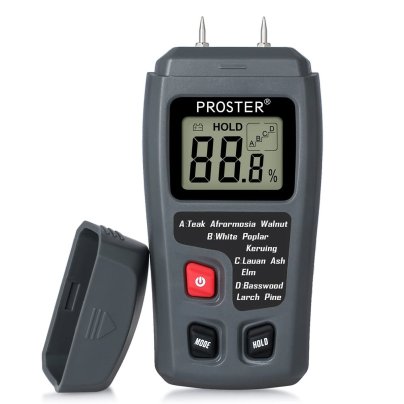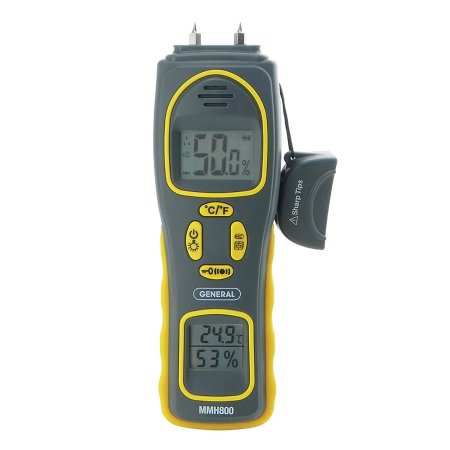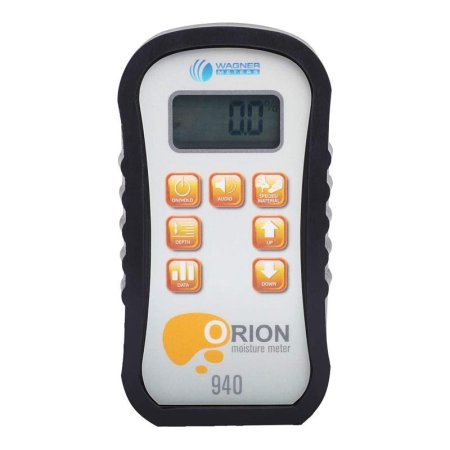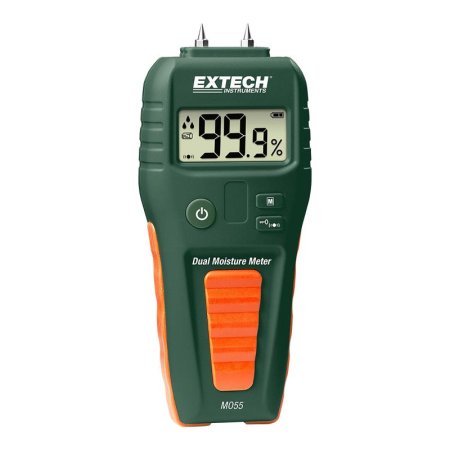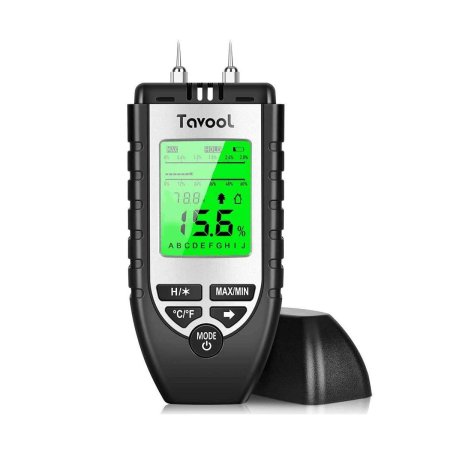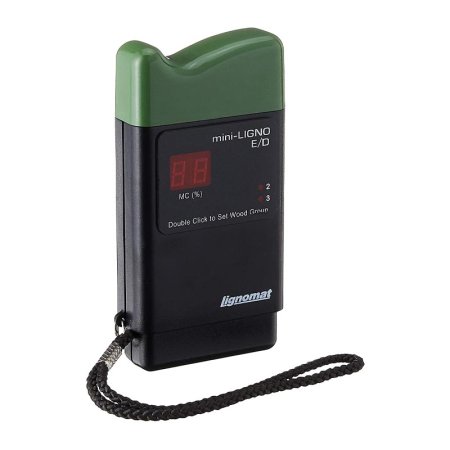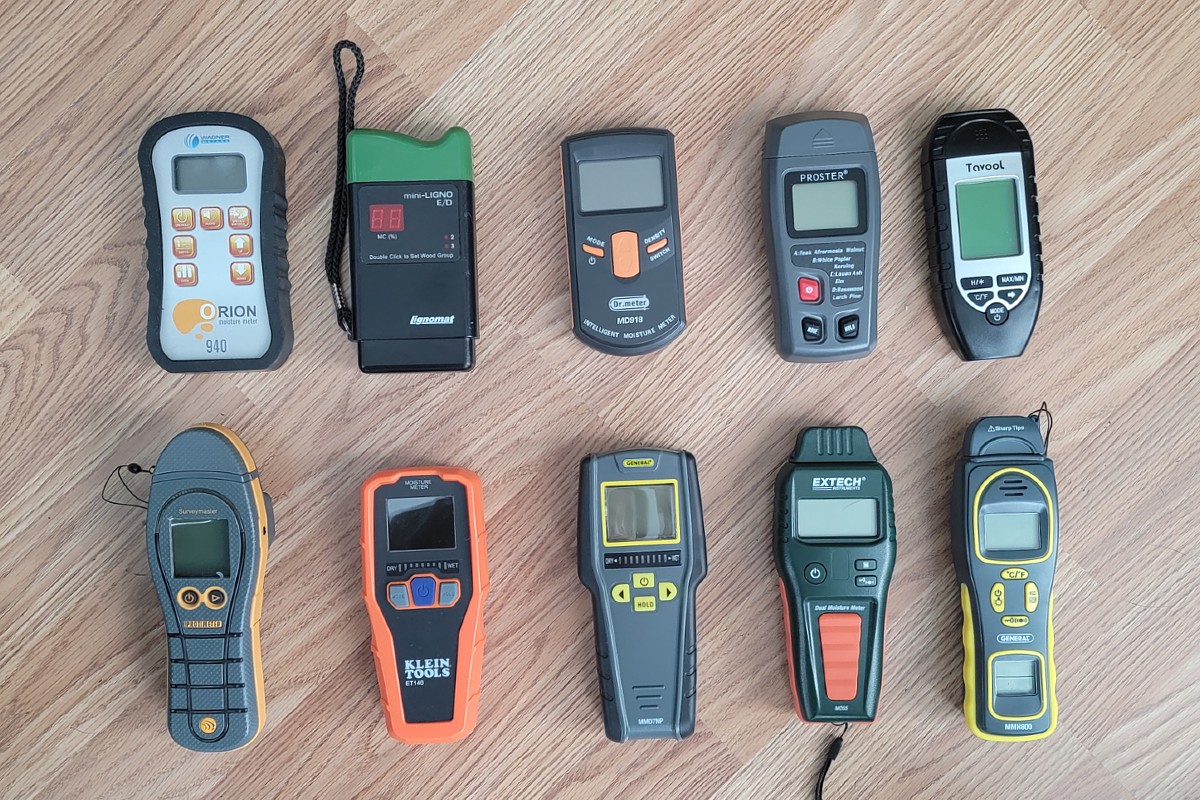
We may earn revenue from the products available on this page and participate in affiliate programs. Learn More ›
Moisture meters can test the moisture content of many different materials, including drywall, paneling, and wood studs. Furniture makers and other woodworkers use them frequently to ensure they’re working with a quality product, and flooring contractors use the meters to determine ideal moisture conditions when installing a laminate or wood floor over a concrete slab or subfloor.
For home and building inspectors, a moisture detector is a necessary tool for verifying the condition of a home. Similarly, you can use this tool to verify that your home is moisture-free or ensure the quality of materials during DIY projects. A moisture meter can help you determine if there is too much moisture or your home needs a dehumidifier.
Our favorite is the General Tools Digital Pin/Pinless Moisture Meter. We like it because of its built-in temperature and humidity sensors, pin/pinless design, holes built into the cap for quick calibrating, and durable storage case.
This guide features hands-on testing of the top-rated moisture meter options available. Some passed with flying colors, while others didn’t make the cut.
- BEST OVERALL: General Tools Digital Pin/Pinless Moisture Meter
- BEST BANG FOR THE BUCK: Proster Digital Handheld Moisture Meter for Wood
- UPGRADE PICK: Wagner Meters Orion 940 Pinless Wood Moisture Meter
- BEST COMBINATION: Teledyne Flir Extech MO55 Pin/Pinless Moisture Meter
- BEST FOR WOOD: Tavool Digital Pin Moisture Meter for Wood
- BEST EASE OF USE: Lignomat Mini-Ligno E/D Pin Moisture Meter
- BEST FOR PROFESSIONALS: Protimeter BLD5365 Surveymaster Moisture Meter
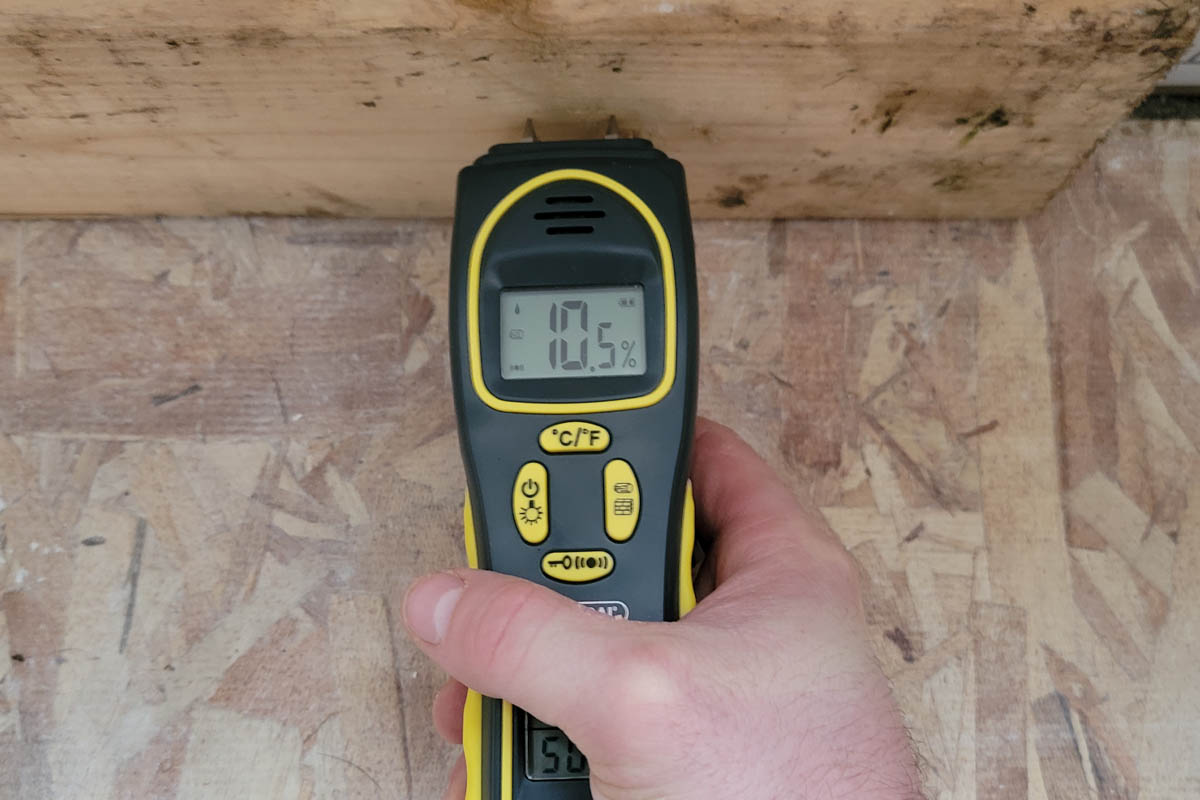
Product Comparison
| Style | Range | Accuracy | |
| General Tools Digital Pin/Pinless Moisture Meter | Combination | 5 percent to 50 percent in wood; 1.5 percent to 33 percent in building materials | 3 percent |
| Proster Digital Handheld Moisture Meter for Wood | Pin | 0 percent to 99.9 percent in wood | 0.5 percent |
| Wagner Meters Orion 940 Pinless Wood Moisture Meter | Pinless | 4 percent to 32 percent | Unspecified |
| Teledyne Flir Extech MO55 Pin/Pinless Moisture Meter | Combination | – 5 percent to 50 percent in wood; 1.5 percent to 33 percent in building materials (pin) – 0 percent to 99 percent in wood and other materials (pinless) | 3 percent |
| Tavool Digital Pin Moisture Meter for Wood | Pin | 6 percent to 60 percent in wood; 0 percent to 40 percent in building materials | 2 percent |
| Lignomat Mini-Ligno E/D Pin Moisture Meter | Pin | 6 percent to 45 percent | 0.5 percent |
| Protimeter BLD5365 Surveymaster Moisture Meter | Pin | 7.9 percent to 99.9 percent with pins, and 70 to 999 with the pads | 1 percent |
Our Top Picks
The top-rated products below were chosen for quality, price, and customer satisfaction to help you find the best moisture meter for your projects. And, to make sure you know everything you need to, we performed hands-on testing with several models. The following meters are ranked among the best.
Best Overall
General Tools Digital Pin/Pinless Moisture Meter
What We Like
- Great versatility for multiple projects
- Pin and pinless design for added flexibility
- Comes with durable case
- Cap has holes
What We Don’t Like
- Temperature resets to Celsius every time it’s powered on
- No “mold tester” as description claims
Product Specs
- Style: Combination
- Range: 5 percent to 50 percent in wood; 1.5 percent to 33 percent in building materials
- Accuracy: 3 percent
This multifunctional moisture meter helps DIYers test for moisture using pinless, flat sensors without damaging the material. If the meter finds moisture, the user can remove the cap to expose two pins for accurate moisture measurement within 3 percent, humidity measurement within 5 percent, and temperature measurement within 2 degrees.
Considered the best moisture meter for plaster walls, it can be used for drywall, carpeting, flooring, brick, grout, soil, paper, or powders, and it shows readings on two bright displays. The meter has a moisture level range of 5 percent to 50 percent for wood and 1.5 percent to 33 percent for other building materials, plus a humidity range of 25 percent to 95 percent and a temperature range of 32 to 140 degrees.
During testing, this General Tools digital moisture meter proved to be accurate and easy to use. We liked that it didn’t take much setup, and there aren’t any complicated charts to read in order to set it to the correct species. The built-in temperature and humidity sensors work well and are easy to read. Also, we like that we could use the cap to check our calibration. The only thing that we found frustrating is that it reverted to Celsius every time we turned it off and back on. Also, there is no “mold tester” as the product description claims.
Get the General Tools digital moisture meter at Amazon or General Tools.
Best Bang for the Buck
Proster Digital Handheld Moisture Meter for Wood
What We Like
- Screen is simple and very easy to read
- Versatile tool with broad temperature range
- Very easy to use with no complicated settings
- Affordable compared to other moisture meters
What We Don’t Like
- Designed for wood use only
Product Specs
- Style: Pin
- Range: 0 percent to 99.9 percent in wood
- Accuracy: 0.5 percent
This digital handheld moisture meter from Proster is made for use with wood and wood products only. This specialization comes with two big benefits: The first is that DIYers can get this moisture meter for a bargain compared to other models. The second is that the Proster can provide impressive accuracy to within 0.5 percent on a massive scale of 0 percent to 99.9 percent for wood, firewood, logs, cardboard, paper, and other wood products.
The pin moisture meter settings can switch between four different wood groups containing 50 wood species for precision measurement. The large LCD screen is easy to read, and the body of the device comes in sturdy ABS plastic for superior durability. This moisture meter won’t work with concrete, gypsum, drywall, or other nonwood building materials, but DIYers with wood-based projects have an affordable specialty pick.
We really like the Proster meter. Unlike other models that require lengthy user manual reads and have complicated settings, this affordable meter has everything we need to know displayed right on the front. We liked the wide range, though we suspect that anything above 70 percent would probably feel like it was dripping wet to the touch. The only real drawback of the Proster is that it’s for wood use only, meaning it isn’t very helpful for locating leaks or moisture in building materials.
Get the Proster moisture meter at Amazon or Proster.
Upgrade Pick
Wagner Meters Orion 940 Pinless Wood Moisture Meter
What We Like
- Incredibly accurate (despite an unspecified accuracy by the manufacturer)
- Comes with a calibration plate and durable carrying case
- Adjustable for several tree species
What We Don’t Like
- Limited moisture range only up to 32 percent
Product Specs
- Style: Pinless
- Range: 4 percent to 32 percent
- Accuracy: Unspecified
For shoppers with extra room in their meter budget, the Wagner Meters Orion 940 is one of the best pinless moisture meter options worth considering. While the model might be a bit expensive, it does offer deeper, more accurate readings than most meters, and it does it without pins.
This model from Wagner Meters features a measurement range of 4 percent to 32 percent. It also comes with a chart that allows the user to calibrate it to a specific value assigned to a species, offering the most reliable readings possible. And, unlike many other pinless meters, this model can take measurements in wood as thick at 1.5 inches, or the full thickness of a stud. Should you question its calibration, it comes with a calibration plate for checking at any point.
There’s a bit of a learning curve when it comes to the Orion. First, we had to read the manual to discover how to change the species setting, but once we did, the change was easy. Also, cycling through the calibration, species, and materials menu was a little confusing at first. Although it doesn’t have a tremendous range, it was incredibly accurate and consistent. Truth be told, we used this model as the baseline for accuracy in our test.
Get the Wagner Meters moisture meter at Amazon, Acme Tools, or Wagner Meters.
Best Combination
Teledyne Flir Extech MO55 Pin/Pinless Moisture Meter
What We Like
- Easy to use with a simple screen
- Offers visual guide and audio alerts for moisture content
- Ideal when precision is key
What We Don’t Like
- Material setting button seems sensitive
Product Specs
- Style: Combination
- Range:
- Accuracy: 3 percent
Anyone looking for a combination pin/pinless moisture meter might not want to overlook the Extech MO55 pin/pinless moisture meter from Teledyne Flir. This meter offers accurate pinless readings between 0 percent to 99 percent in both wood and other building materials, as well as a 5 percent to 50 percent range in wood and 1.5 percent to 33 percent range in building materials when using the pins.
A calibration test in the cap allows users to check the Extech’s accuracy before relying on its readings. It also features a visual guide to moisture, with one digital raindrop representing dry wood, two drops for medium moisture, and three representing wet wood.
When we were testing the Extech in pin mode, we continued to press the materials button, which would inevitably give us a reading of our index fingers rather than the material we were testing. Beyond that, we liked how easy the Extech was to use, and we appreciated the digital raindrops and audio alerts that speed up according to a wood’s moisture content. And, we continued to check this model’s accuracy with its built-in calibration gauge.
Get the Teledyne Flir Extech moisture meter at Amazon, Acme Tools, or Teledyne FLIR.
Best For Wood
Tavool Digital Pin Moisture Meter for Wood
What We Like
- Excellent pin design
- Includes a built-in thermometer for added versatility
- Best digital screen in the test
What We Don’t Like
- Many of the tree species in the guide go by their scientific names
Product Specs
- Style: Pin
- Range: 6 percent to 60 percent in wood; 0 percent to 40 percent in building materials
- Accuracy: 2 percent
The Tavool digital moisture meter is an excellent addition to any woodworking shop. This moisture meter for wood comes with seven calibration scales for wood so DIYers can be as precise as possible with their measurements at an accuracy within about 2 percent. The pin moisture meter also can measure the temperature of the material within 4 degrees to help quickly track down leaks.
The moisture meter uses a scale of 6 percent to 60 percent for wood and 0 percent to 40 percent for other building materials. Its big, backlit LCD screen makes for easy readability, even in dim lighting. A “Hold” key freezes readings on the screen, while the built-in memory function stores readings so the user doesn’t have to keep track.
The Tavool was one of the biggest surprises we found during testing. For one, the digital screen is both easy to read and full of information. We liked that this moisture meter features a built-in temperature sensor as well. But the one “point” we liked most about the Tavool was its pin design; the pins are long and thin enough to plunge deeply into wood but not so thin that they’re not durable. The only issue we found came when adjusting for species. Tavool, for some reason, included scientific names for tree species. We didn’t bring our biology book, so we had to do a lot of googling.
Get the Tavool moisture meter at Amazon.
Best Ease of Use
Lignomat Mini-Ligno E/D Pin Moisture Meter
What We Like
- Doesn’t get any easier to use
- Extreme accuracy
- Cap forms a comfortable handhold
What We Don’t Like
- Feels like an old-school design (but is that really bad?)
Product Specs
- Style: Pin
- Range: 6 percent to 45 percent
- Accuracy: 0.5 percent
The Lignomat Mini-Ligno E/D moisture meter is a premium tool designed for a specialized purpose. This pin moisture meter comes calibrated for use with wood and wood products, but it boasts an accuracy of 0.5 percent on a precision scale of 6 percent to 45 percent. Its sturdy body is easy to hold and use, with sharp pins that can push through even the toughest wood.
The body of the moisture meter holds a longer second set of pins for deeper penetration, but the real benefit of this model is the simplicity of the design. Select the wood type to be measured, then push the pins into the material. A unique on-off switch between the pins activates the meter so the user only has to look at the reading on the bright, digital LED display.
We’ll try not to gush, but the Lignomat moisture meter is pretty much everything you need from a moisture meter, and it’s by far the easiest to use in the group. First, this thing doesn’t even have a power button; simply poke it into a piece of wood and it will give you a reading. Second, it provides readings for a wide range of species while only requiring the user to switch between “Group 2” or “Group 3”—no fancy calculations necessary. And, we couldn’t help but enjoy the Lignomat’s accuracy and the way the cap forms a comfortable hand-hold during testing. If we’re going to complain about something, it’s that this thing looks and feels like it’s straight out of the 1980s, but we’re not so sure nostalgia is a bad thing.
Get the Lignomat moisture meter at Amazon or Acme Tools.
Best for Professionals
Protimeter BLD5365 Surveymaster Moisture Meter
What We Like
- Comprehensive tool set with plenty of accessories
- Very accurate
- Excellent pin penetration for deep readings
What We Don’t Like
- Pinless readings are not shown as a percentage
- Doesn’t adjust for species
Product Specs
- Style: Pin
- Range: 7.9 percent to 99.9 percent with pins, and 70 to 999 with the pads
- Accuracy: 1 percent
The Protimeter BLD5365 Surveymaster professional moisture meter is dual functional but doesn’t just use standard pins and pads to take readings. It also features a set of 5-inch pins for deep penetration and a moisture probe that can plug into the unit to help with taking readings in difficult-to-access areas. It even includes a calibration tool to ensure the readings are accurate.
The heavy-duty design and highly accurate moisture readings within 1 percent make this a must-have tool for discerning DIYers and industry professionals like contractors, surveyors, inspectors, and many more. With two modes of operation for search (pinless) and measure (pin), the moisture meter works with concrete, wood, tile, vinyl, drywall, and many other building materials with a scale of 7.9 percent to 99.9 percent using the pins and a relative scale of 70 to 999 using the pads (where 70 to 169 is dry, 170 to 199 is at risk, and 200 to 999 is considered wet).
During testing, we liked the accessories and could definitely see their usefulness. Even grabbing readings from boards right in front of us was easier, since we could look at the display while getting the reading at the same time. Also, we enjoyed the 1 percent accuracy and excellent pin penetration. Our only concerns were that we would prefer the pinless readings in a percentage, and we couldn’t adjust it for species.
Get the Protimeter moisture meter at Amazon.
Also Tested
We also tested the General Tools pinless digital moisture meter and the Klein Tools ET140 pinless moisture meter; however, neither of these models passed our tests.
The General Tools pinless moisture meter uses a measurement range of 0 percent to 53 percent for softwoods like pine, a range of 0 percent to 35 percent for hardwoods like maple, and a relative scale for drywall and masonry. This meter was difficult to use, and didn’t register moisture readings anywhere near the range of the other models on the list. It could’ve been a calibration issue, but since it automatically calibrates, we didn’t have any luck.
The Klein ET140 is a durable pinless moisture meter that calibrates for each material with the push of a mode button that switches between types of material for precise measurement. Unfortunately, during our repeated testing of this model, it consistently read 4% moisture and the unit could not be recalibrated after multiple attempts. We’re big fans of Klein Tools, but this one didn’t make the grade.
Jump to Our Top Picks
How We Tested the Best Moisture Meters
Typically, we love testing products, but this moisture meter test was tough. First, every meter had a different range and accuracy rating, which made establishing baselines difficult. While we were conducting moisture meter reviews, we found that each product had a different method of adjusting for certain species, so we spent an entire day reading user’s manuals—surely a better test for eyeglasses and patience than moisture meters.
Eventually, with everything dialed in as well as possible, we began checking moisture levels. For some variety, we used three pieces of pine lumber from a recent project. One piece soaked in a bowl of water overnight. The other piece sat in an oven and dried at 225 degrees for 2 hours. The third piece was left alone. We checked each of the meters using all three of these pieces of lumber and compared readings.
Next, we checked the meters on a small section of drywall, a small section of concrete foundation, and an unfinished oak stair tread. Those readings were collected and compared as well.
Finally, we went through all the settings, modes, and extra features (for those that had them). At this point, we had a solid grasp on which models were worth the money and which we needed to discard from the test.
What to Consider When Choosing a Moisture Meter
Before purchasing a moisture meter, it’s a good idea to educate yourself about these important considerations to make sure that you settle on the appropriate product for your purposes.
Types of Moisture Meters
DIYers and professionals in industries like home inspection, fine carpentry, and flooring use three common types of moisture meter: pin, pinless, and multifunctional.
Pin
Pin moisture meters get their name from the two metal prongs, or pins, that emerge from the top of the meter like antennae. These pins are what measure the moisture percentage. Using a pin moisture meter requires aligning the pins with a spot on the material, and then pushing them so they penetrate the material.
Once the pins are inserted, users can operate the moisture meter with a control pad to send an electrical signal down one pin. This signal travels through the material on its way to the other pin. The moisture meter uses this signal to measure the material’s resistance to electrical current, which can help determine its moisture content.
This method of measurement is considered invasive because it requires puncturing the material to obtain a result. However, pin moisture meters are the only type that can help identify the exact location of moisture.
Pinless
Pinless moisture meters, so named for their lack of measurement pins, do not penetrate the material to get a reading. Instead, a plate on the back of the meter lays flat against the material and a high-frequency signal travels through it. The signal changes based on the material’s ability to store an electrical charge, which enables the moisture meter to detect the levels of moisture in the substance.
The main benefit of pinless moisture meters becomes clear when testing drywall. Having to drive holes into drywall to detect moisture can quickly turn it into Swiss cheese. A pinless moisture meter can check for moisture multiple times without damaging the drywall.
Although pinless moisture meters are less invasive than pin meters, their readings show moisture in a general area rather than a specific spot. A good option for regular moisture detection is a multifunctional moisture meter. Multifunctional moisture meters use both methods of measurement for noninvasive, precise moisture detection if an issue is discovered.
Accuracy
DIYers and pros looking for a moisture meter place accuracy as one of the most important factors in deciding which one to buy. A unit lacking in accuracy is essentially useless for measuring moisture. However, not all units advertise the same accuracy rate.
High-quality moisture meters should be accurate to within 0.1 percent, but these high-end models can cost a lot. For a less-expensive option, some moisture meters are accurate to within 5 percent. This still represents a reasonable accuracy rating for the average DIYer, but if a project or professional requires a more precise measurement, it is best to stick to the high-end models. It isn’t advisable to invest in a moisture meter that has more than a 5 percent variance in its accuracy.
All moisture meters’ readings are displayed as a percentage of moisture content (% MC). Typically, a moisture meter is calibrated for use with wood and has a scale between 5 percent (dry) and 40 percent (saturated). Measuring nonwood materials like concrete uses a relative scale from 0 (dry) to 100 (saturated). Moisture meters for use with gypsum or drywall offer a third scale that ranges from 0.2 percent (dry) to 50 percent (saturated). Before deciding on a moisture meter, determine the accuracy levels you need and the materials you will want to check.
Durability
A product’s durability is important to anyone who will be using a moisture meter regularly on job sites. Even a newer model with the best features should survive having its pins pushed into a wall or being jostled in a tool box.
The moisture meter should include the features a DIYer wants but also have a reputation for durability and long life. Consider options that have a rubberized casing, a heavy-duty design, or shock resistance built in. These moisture meters will survive a few falls without damage and make a great investment because they’ll need to be replaced less frequently.
Ease of Use
Choose a moisture meter that is relatively simple to use. Complicated moisture meters take much longer to read than those with a more straightforward design and can lead to inaccurate and inconsistent readings that could result in undetected moisture damage.
Instead, opt for a moisture meter with an easy-to-read, backlit digital display that shows the information you need. Users should be able to navigate easily between the menus on the device and switch between functions quickly. Pinless moisture meters are much easier to use than pin moisture meters, but the trade-off is in pinpoint accuracy.
Range of Measurement
The range of measurement a moisture meter offers is determined by the minimum and maximum moisture percentages it can read. The broader the range of measurement, the less precisely the device will measure, with some moisture meters offering as wide a range as 0.2 to 60 percent.
Smaller, more precise scales provide more accurate measurement and frequently come in meters used in the flooring and fine carpentry industry to ensure optimal moisture percentage. However, most DIYers would benefit more from a broader scale range so they can use the same meter for many applications.
Additional Features
Moisture meters, like most electronic devices, can pack plenty of additional features to make the task easier. One of these features is a temperature display that can track a hot or cold water leak. Following changes in the temperature helps locate the source.
Other features include memory functions that can keep track of previous readings instead of having to write them down or remember them, audible alerts for the moisture level reading, and a carrying case to protect the moisture meter.
The Advantages of Owning a Moisture Meter
Having a moisture meter handy can save you a lot of trouble in your home and with DIY projects. It is easy to quickly test areas that look like they might be accumulating moisture to determine whether there is an issue. By taking the reading yourself, you avoid having to call a professional inspector and paying a costly fee only to find no moisture problem exists. If you have frequent problem areas in your home or in a high-moisture basement or cellar, a moisture meter can take regular readings to quickly identify and treat mold growth.
In addition, a moisture meter improves the outcome of DIY projects by providing accurate moisture readings for flooring projects, when installing wallpaper, and during woodworking projects. Without a moisture meter, DIYers only can guess at the moisture content in a material, which could lead to problems with mold growth or structural issues if the moisture buildup becomes severe.
- Owning a moisture meter helps you to detect problems without having to call in a professional.
- Regular readings in high-moisture homes can help detect and stop mold growth.
- Using a meter for flooring, wallpapering, and other DIY projects will ensure a high-quality finish and appropriate moisture percentages.
FAQs
Before buying a new moisture meter, take a look at the most frequently asked questions and their answers below.
Q. How does a moisture meter work?
Pin moisture meters work by measuring the resistance an electrical current meets when passing through a material. Inserting the pins into the material sends a current down one pin to flow into the second. The meter then measures the resistance the current met traveling through the material between the pins to generate a moisture reading.
Pinless moisture meters use a high-frequency signal to permeate the material. The electrical signal changes based on the material’s ability to hold a charge, and the moisture meter receives a measurement of the moisture content in the material.
Q. What is a normal reading on a moisture meter?
In general, a reading of 5 to 12 percent is optimal, but a normal reading on a moisture meter depends on the material. Drier materials like drywall should have lower moisture readings of around 5 to 7 percent. Damp materials like wall studs and framing lumber have acceptable moisture levels of up to 12 percent.
Q. What is a bad moisture meter reading?
A bad moisture reading would be one that climbs to 20 percent or higher—in this environment, your porous materials like lumber may be susceptible to mold growth or decay.
Q. Does moisture in walls mean mold?
Not necessarily. A moisture meter can be used to help detect problem areas, but it cannot detect mold. The hope is that you would use the moisture meter to detect a leak before the mold can form. But if the moisture is left untreated, it can become the perfect environment for mold spores to flourish.
Q. How do you use a moisture meter on drywall?
To use a moisture meter for drywall, first ensure that the meter is calibrated to accurately measure moisture in the material. If the meter is not calibrated, the results will be inaccurate.
Once the meter is calibrated to test drywall, operate the moisture meter normally according to product instructions. Insert pin meters into the drywall in several different spots to get an accurate reading of the entire wall. Similarly, a pinless meter should scan several sites on the wall for a full scope of its moisture content. For drywall, a reading of 5 percent to 7 percent is optimal.
Q. Are moisture meters accurate?
A dependable moisture meter may boast an accuracy within 3 percent of the reading, with some professional-grade models getting within 0.5 percent.
The accuracy of a moisture meter varies depending on the material you are testing, the calibration of the meter, the type of moisture meter, the procedures used during the test, and the meter’s functionality, which can vary based on upkeep and maintenance of the unit.
Above all, a moisture meter for walls and other structures will be most accurate if used correctly. A high-quality moisture meter used on the correct material by an experienced DIYer can accurately measure moisture to within 0.1 percent. However, an inexpensive moisture meter used on an inappropriate material without a proper scale could return inaccurate readings in the same way that a poor-quality stud finder can fail to find a stud if used improperly.

